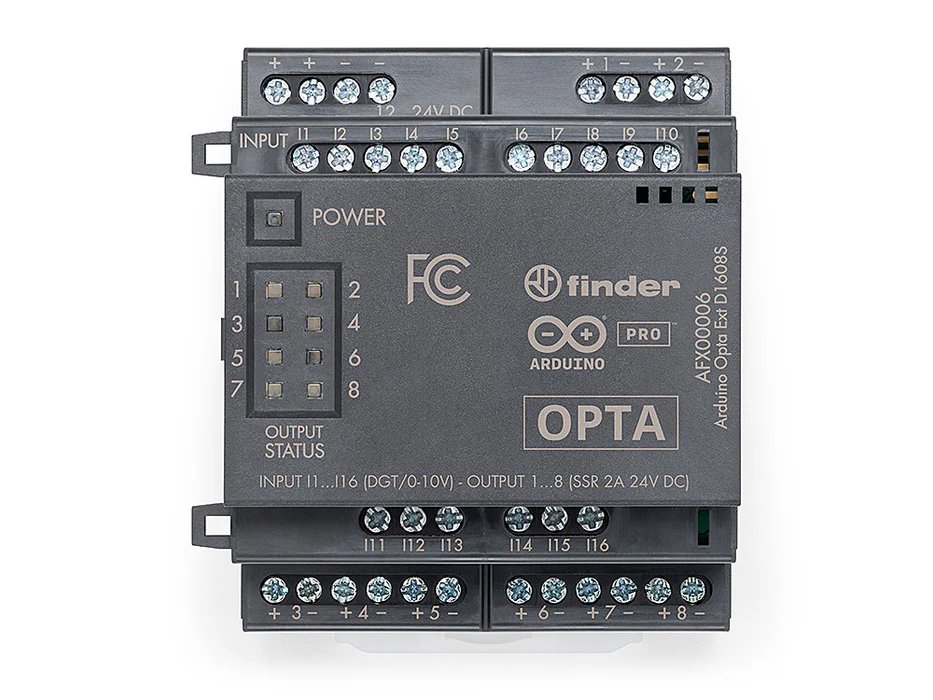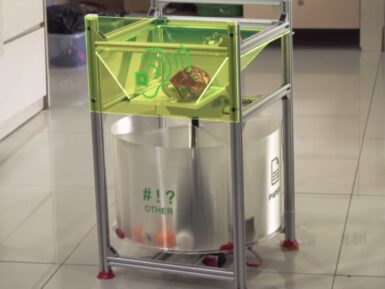
Arduino Pro Opta Ext D1608S
The snap-on expansion module to enhance Arduino Opta’s applications with the addition of 16 programmable voltage inputs and 8 solid-state relays.
Overview
Arduino Pro Opta Ext D1608S enhances your Arduino Opta’s real-time control, monitoring and predictive maintenance applications with the addition of 16 programmable voltage inputs and 8 solid-state relays 24 VDC 2A.
Just snap on the module to extend your system’s capabilities flexibly and quickly, and manage the new I/Os from the Opta base unit seamlessly, taking advantage of the open and widely known Arduino ecosystem or PLC IDE IEC 61131-3 programming environment.
Key benefits:
- Flexible inputs: 16 new inputs for your applications per each expansion added, programmable as digital 0-24 VDC or analog 0-10 V.
- Powerful outputs: 8 solid-state relays offering 24 VDC for 2A each.
- Up to 5 snap-on modules can be managed to multiply and mix a set of I/Os with seamless detection: snap them right next to your Opta base module and use the I/Os as native Opta resources.
- Extend your hardware capabilities while keeping programming accessible, by using the Arduino IDE with its wide range of ready-to-use sketches, tutorials and libraries.
- Put your new I/Os easily to work with the PLC IDE for IEC 61131-3 PLC languages, taking advantage of its low-code approach and pre-mapped resources.
- Extend the Opta’s benefits of real-time remote monitoring via intuitive Arduino Cloud dashboards and secure communication to a wider set of connected devices.
- Reliable by design, thanks to industrial certifications and Finder’s expertise in electronic devices.
- Easy DIN rail installation.
Applications
Opta’s digital expansions are ideal to increase the number of real-time control points in the manufacturing sector and in any building automation project.
The Opta Ecosystem is compatible with all major cloud providers – but choosing the simplicity of Arduino Cloud can really make a difference, for anyone who wants to build, customize and remotely manage their own dashboards.
Looking for a similar option?
Check out the Arduino Pro Opta Ext D1608E, to add 8 electromechanical relays 250 VAC 6A to your Opta-based solution.
Conformities
Resources for Safety and Products
Manufacturer Information
The production information includes the address and related details of the product manufacturer.
Arduino S.r.l.
Via Andrea Appiani, 25
Monza, MB, IT, 20900
https://www.arduino.cc/
Responsible Person in the EU
An EU-based economic operator who ensures the product's compliance with the required regulations.
Arduino S.r.l.
Via Andrea Appiani, 25
Monza, MB, IT, 20900
Phone: +39 0113157477
Email: support@arduino.cc
Documentation
Learn more
Get Inspired

Debug your C33 with few steps

In July 2023, Samuel Alexander set out to reduce the amount of trash that gets thrown out due to poor sorting practices at the recycling bin. His original design relied on an Arduino Nano 33 BLE Sense to capture audio through its onboard microphone and then perform edge audio classification with an embedded ML model to automatically separate materials based on the sound they make when tossed inside. But in this latest iteration, Alexander added several large improvements to help the concept scale much further. Perhaps the most substantial modification, the bin now uses an Arduino Pro Portenta C33 in combination with an external Nicla Voice or Nano 33 BLE Sense to not only perform inferences to sort trash, but also send real-time data to a cloud endpoint. By utilizing the Arduino Cloud through the Portanta C33, each AI-enabled recycling bin can now report its current capacity for each type of waste and then send an alert when collection must occur. While not as practical for household use, this integration could be incredibly effective for municipalities looking to create a network of bins that can be deployed in a city park environment or another public space. Thanks to these upgrades, Alexander was able to submit his prototype for consideration in the 2023 Hackaday Prize competition where he was awarded the Protolabs manufacturing grant. To see more about this innovative project, you can check out its write-up here and watch Alexander’s detailed explanation video below.












